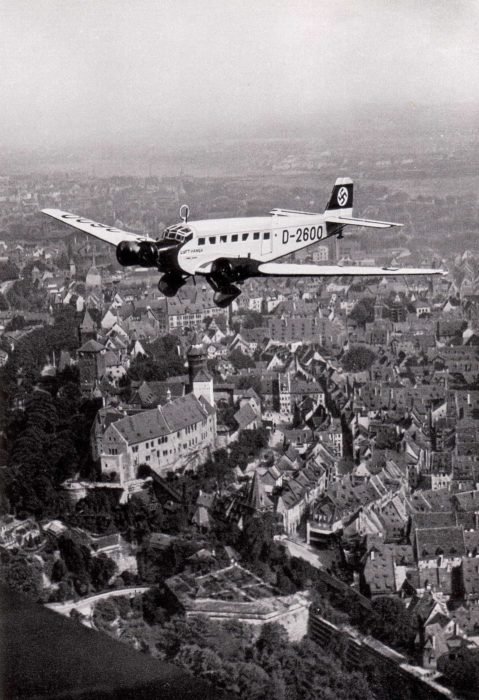
Swastika Night was written by Katharine Burdekin under the pseudonym Murray Constantine. It’s a dystopian novel in which Nazi Germany and Imperial Japan have conquered the world and divided it between them. Nothing so original in that, you might think — except that Swastika Night was published in June 1937, before the invasion of Poland and even before the Marco Polo Bridge Incident. So it’s not, strictly speaking, an alternate history, but an uncanny form of one.
Swastika Night is set over 600 years after the death of Hitler, whose historical reality has long been forgotten: he is literally worshipped as the giant, blond god of the Nazi religion. Europe (and presumably most of the area under Nazi rule) is now a feudal society, controlled by hereditary Knights. Women are used only for reproduction and taught to despise themselves. Christians are a minor, hated sect; most of the subjugated peoples of Europe follow the Nazi religion, which nevertheless places them low on the racial hierarchy. The Jews, of course, have vanished entirely. The Nazis long for war against Japan but the Knights know they cannot win. Shere is an uneasy peace between the two empires.
A nightmarish world. Burdekin’s feminist critique of fascism is searing; it’s unsurprising that it was a Left Book Club selection in 1940. Unfortunately, I found the story less than compelling, being so heavily burdened with expository dialogue as it is. The loss of historical knowledge about the wars of conquest means that there aren’t really any mini-wars-to-come, as you got in other mid-century British dystopias like Brave New World or 1984. Late in the novel a room under a hill near Stonehenge, containing ancient skeletons and small arms, becomes an important scene: as it’s described as a ‘an old gas chamber or dug-out’, that suggests that gas may have been used in the last war. But there aren’t many details, otherwise.
There was something about Swastika Night which made me take notice almost from the start, however, and that is its airmindedness. Because the Nazi religion has as its central symbol and artefact a Sacred Aeroplane, which exist, in ‘a church in the Holy City [Munich], where the Sacred Hangar was’,
towards which all the Swastika churches in Hitlerdom were oriented, so that the Hitler arm [of the local church] was in the direct line with the Aeroplane in Munich, even though thousands of miles lay between the Little Model in the Hitler chapel and the Thing Itself.1
As it happens, Alfred, the protagonist, is an ‘English technician, of Bulfort Aerodrome, Salisbury Plain, province of England’, on a pilgrimage to the German holy sites.2 We don’t get to visit the Sacred Hangar in the novel, but he is curious to see the Sacred Aeroplane with his own expert eye:
Well, I shall still be thinking when I see the Aeroplane, partly technically no doubt, though I’m acquainted with the design of the thing from the Little Models, and as far as I can make out there’s been no real change in aeroplanes at all.3
Being a foreigner, Alfred is allowed to repair aeroplanes but not to fly them — but he gets a chance to, nevertheless, and it turns out that he’s a natural pilot:
Alfred went on up, as fast as he could make the machine climb. He was intoxicated. He wanted to get about a mile above Germany and then lay the course straight for England, and fly till he got there, and then hide the aeroplane in some secret place. And what should he do with the Knight? Kill him, kill him! Kill every Knight and every Nazi that dared to stop a man flying! Kill them all!4
This leads him to think impure thoughts:
There below them lay the Holy City of Munich, quiet and white in the afternoon sun. Alfred would have liked to drop a bomb on it, particularly and specially on the Sacred Aeroplane.5
The Sacred Aeroplane seems to be the one in which, according to the Nazi religion, Hitler ‘flew to Moscow in the Sacred Aeroplane at the head of the air fleet’, presumably to destroy it and end the war with Russia.6 That certainly fits with the Nazi glorification of violence, in Burdekin’s day and in her novel. But it also made me think of Hitler’s flight over Nuremberg in a Junkers Ju 52/3m at the start of Leni Riefenstahl’s Triumph of the Will, which is often seen as portraying Hitler as a god descending from the clouds:
(The photo of Hitler’s Ju 52/3m at the top of the post is not from Triumph of the Will, but seems to have been taken during the same flight.) Triumph of the Will was released two years before Swastika Night, so it’s possible that Burdekin saw it. A quick check of the British Newspaper Archive doesn’t suggest it was widely shown in British cinemas, or at all, for that matter. But as an anti-fascist feminist, she would have been appalled but perhaps intrigued by another woman’s Nazi propaganda: in Swastika Night she is critical the way that women connived at their own subjugation by supporting Nazism. In any case, Burdekin’s Sacred Aeroplane is a fitting example of the winged gospel gone wrong.
Image source: The Age of Uncertainty.
![]() This work is licensed under a Creative Commons Attribution-NonCommercial-NoDerivatives 4.0 International License.
Permissions beyond the scope of this license may be available at http://airminded.org/copyright/.
This work is licensed under a Creative Commons Attribution-NonCommercial-NoDerivatives 4.0 International License.
Permissions beyond the scope of this license may be available at http://airminded.org/copyright/.



